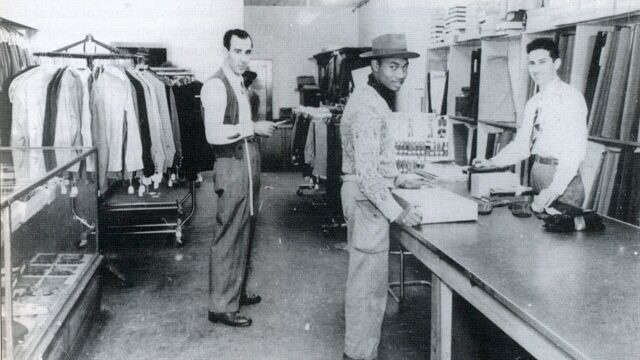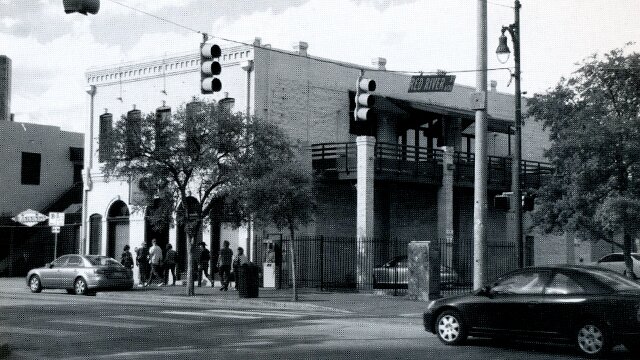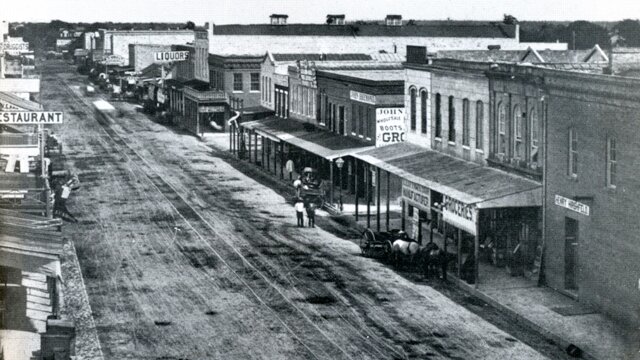“A big rat came out of one of the old buildings and scampered into an alley. A discarded newspaper fluttered against a parking meter in the early morning breeze. Keys grated in locks and doors opened and the smell of hot coffee came into The Street.
East Sixth Street was open for business.”
– Dan Grover, Austin American Statesman, July 1953
Austin’s most famous street has earned the nickname “Dirty Sixth” over the past few years, with a boozy, unruly Bourbon Street-like atmosphere and a YouTube driven reputation for violence. You almost forget the history of the street whose majority of buildings, even those housing tattoo parlors, frat bars and gawdy gift shops, were erected in the late 1800s.
The mob that mills between the barricades on weekends tripled during South by Southwest and became menacing, with street brawls and cops in riot formation. “SXSW has lost Sixth Street” was my shortest tweet of the week, as I gave up trying to see a band that was just two blocks away. The few, miserable-looking badge-wearing registrants I saw moved through the roving street gangs and drunken frats like they were navigating chest-high swampwater. This was not in the brochure!
The proximity of clubs on Sixth, many of which change to live music venues for a week to catch a whiff of the windfall, was a key to the appeal of SXSW in the early years. But during this past fest, two forays into the fray reminded me of that line from Apocalypse Now: “Don’t get out of the boat.” Absolutely goddamn right. Why would I ever leave South Austin during the third week of March?
This Saturday will be another crazy time on Sixth, as the last night of the Texas Relays has become the traditional Black Party Night in Austin. Not only will there be the Urban Music Festival at Butler Park (starring Kool and the Gang), but Sixth will be packed from Brazos to Red River Streets with tens of thousands of African-American teenagers and young adults trying to hook up.
Stubb’s tried to capitalize on the crowd one year and held a big hip-hop show with national acts. But they sold fewer than 60 tickets to the 2,000-capacity venue. Two blocks was too far from the real action, called “parking lot pimpin’,” with the closed-off street creating a free venue.
Some Sixth Street merchants and club owners made news a few years ago when they closed the night of Black Saturday, some nailing plywood over their windows. Their venues didn’t cater to the crowd and none of their usual customers could get through the mob, they argued, but the moves smacked of racism.
History reminds us that Sixth Street, which turns 175 years old in May, was built on true diversity. While the rest of Austin abided by rules of Jim Crow segregation, East Sixth was always open to every race. Black businesses were next to white, Lebanese, Chinese and Hispanic storefronts. White businesses on Sixth, like Hyman Samuelson’s Crown Tailors at 408 E. Sixth, advertised on black radio shows, such as Lavada Durst’s “Dr. Hepcat” on KVET. “Now if you want to be draped in shape and hep on down, get your frantic fronts at Crown,” Durst would say.

Crown Tailors at 408 E. Sixth St. circa 1950. Left is master tailor Eli Gonzales. Right is owner Hyman Samuelson. (Courtesy Austin History Center).
Sixth Street is the closest Austin’s ever gotten to 14th St. in Manhattan. And yet today it’s become synonymous with hooligans and loud, stupid noise.
Sixth Street is at a crossroads, with most business owners and patrons pining for the more manageable past. Downtown streetscaping plans have been submitted to wash that “Dirty” right offa the street, making Sixth an “18 hours a day” family-friendly destination. Vote yes on the proposition, known as the Good Luck With That bond.
But when you consider the history of Sixth Street, it’s an avenue well worth saving. Sixth Street is actually the coolest thing about Austin.
I’ve been learning about Sixth in the 2010 book Images of America, Sixth Street, by Allen Childs, an Austin doctor who worked as a boy at his family’s shoe store on E. Sixth St. A lot of things I didn’t know, like Austin’s first HEB, then called H.E. Butts was at 600 E. Sixth Street. The Academy retail chain started as a military surplus shop on Sixth. Twin Liquors grew out of Jabour’s. And Austin’s first J.C. Penney’s was in the building at 204 E. Sixth St. where Alamo survivor Susanna Dickinson once ran a boardinghouse on the second floor, while her husband made caskets on the ground floor.
E. Sixth has the greatest concentration of limestone Victorian commercial buildings west of the Mississippi. But even more impressive is the street’s human legacy. In a 1978 article in the Austin Sun about a fight between preservationists and developers over the 100 block, home then of Antone’s blues club and O.K. Records, Sixth Street was described as “breathing with a truly diverse urban life all its own.” But developers won that battle.

This 1872 Victorian building was erected by Austin’s first black business owner Edward Carrington, who had a grocery store on the ground floor and lived upstairs.
Why Sixth Street and not Fifth or Seventh? Sixth, originally called Pecan Street, became Austin’s east-west Main Street because it was the most level path from the east. And it was the closest street to the Colorado River that didn’t flood when the water would jump the banks in the years before a dam was built in the 1890’s. It was safe to build on well-traveled Sixth Street and so settlers and immigrants built dry goods stores and saloons and sporting houses and hotels. When the Houston and Texas Central Railroad came to Austin in 1871, the town’s population doubled to 10,000 in a year. Pecan Street was dubbed “The Street of Dreams.”
Austin’s red light district of gambling dens and houses of prostitution was called Guy Town and located between Lavaca and Colorado Streets south of Fifth until Mayor A.P. Wooldridge cleaned it up in 1913. But most legitimate business happened on Congress Avenue and Sixth Street.
Congress was segregated, so blacks couldn’t go to the Paramount Theatre. But they could watch movies at the Lyric Theater at 419 E. Sixth St., which was opened by prominent African-American dentist Everett Givens in the 1920s. Blacks were also welcome at the Ritz Theater, which opened in 1929, though they had to sit in the balcony. Austin’s first black business owner Ed Carrington bought an empty lot at 518 E. Sixth (Pecan) St. in 1872 and built a grocery store. Brother Albert opened a blacksmith shop behind the store. You don’t even notice that building at Sixth and Red River on weekends because there’s so much barking human traffic.
The 700 block of E. Sixth became mostly Hispanic at the turn of the 20th century, with Garza’s Meat Market and Austin’s first Tex-Mex restaurant, El Original, across the street from where Easy Tiger is now.
Sixth Street had various Chinese laundries in its early years and a Chinese Restaurant, Joe Lung’s, which opened in 1916 at the current location of Shawn Cirkiel’s Parkside eatery. Lung had been recruited, along with thousands of other Chinese natives, from his home near Canton to help build the U.S. railroads and decided to stay.

Sixth Street looking east in 1875. The railroad brought prosperity to the street four years earlier.
Austin and Sixth Street were born the same day. Mirabeau B. Lamar, who succeeded Sam Houston as president of the Republic of Texas, discovered Waterloo, as Austin was originally called, while camping near the mouth of Shoal Creek while on a buffalo hunt. The town was home to two families at the time. Lamar suggested the location to the commission created to select a permanent site for the capital of Texas and they agreed, renaming Waterloo, Austin in April 1839. Lamar’s agent, Judge Edwin Waller, arrived the next month to lay out the town. In that original 15-block square, he named the north-south streets after Texas rivers and all the east-west streets after indigenous trees.
Sixth Street was Pecan Street until 1884, when the city had overgrown available tree names and decided to go numerical. Two years later, Sixth Street had its crown jewel when cattle baron, Col. Jessie Driskill built Austin’s first grand hotel at the corner of Sixth and Brazos. (Col. Driskill would lose his namesake hotel in a card game about 10 years later.)
Austin’s first financial center, the Littlefield Building, opened at the northeast corner of Sixth and Congress in 1911. For the first half of the 20th century, Sixth Street was bustling. As evidenced by the 1953 Statesman article which remarked that one could buy a reefer

Stevie Ray Vaughan standing in front of OK Records, next to the original Antone’s on Sixth.
on any corner, Sixth Street started to fall on hard times after WWII, when Austin’s first shopping centers and suburban flight drew away customers. When I-35 was built in 1959, erasing the prosperous East Avenue melting pot, it created a barrier from East Austin.
The almighty Driskill closed in 1969 and was saved from demolition only through a campaign that raised $2 million. The next year the Ritz became a porno movie house. “The Street of Dreams” had become Skid Row.
But various Austinites wouldn’t give up on what was once Austin’s most vibrant thoroughfare. Architect David Graeber and wife Jean paid $13,000 for a condemned building at 410 E. Sixth St. in 1968 and turned it into an Architectural Digest-worthy home, with an indoor swimming pool.
Four years later, Ralph McElroy and Randy Baird opened the Old Pecan Street Café, Austin’s continental cuisine debut, in the former Zegub’s shoe repair store at 314 E. Sixth. It became such a sensation that they expanded next door to the former Big State used furniture location.
In 1974, Jim Franklin turned the abandoned Ritz Theater into a music venue. Shannon Sedwick and Michael Shelton kept the Ritz going, then gave Sixth an entertainment anchor with Esther’s Follies, at the same corner of Red River Street where Skinny Pryor once ran the Spanish-language moviehouse, the Cactus Theater.
History should be important to everyone, not just those born here, but the couple in a U-Haul asking directions to Oltorf. So much of our foundation as a city, as a people, is built on six blocks from Congress Avenue east to Waller Creek. Six blocks “with just enough danger to make it interesting,” as the Sun reported in ’78. Six blocks that have represented all of Austin for 175 years.
A little bit of danger and a whole lot of history makes Sixth Street worth revitalizing, no matter what the cost or inconvenience.
Pingback: ()
Pingback: ()